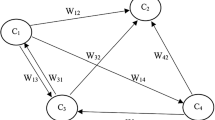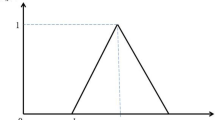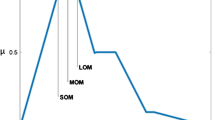Abstract
This research develops a methodological approach aimed at promoting expert knowledge and, as a consequence, exploiting the strength of practical experience in industry in a scientifically rigorous way. In particular, we make use of Fuzzy Cognitive Maps (FCMs) to organise in a flexible way human knowledge about decision-making problems focused on the topic of human risks management. FCMs enable the representation of causal relations among relevant decision-making elements on the basis of spontaneous human brainstorming stimulated from a single expert or a decision-making team. After leading a comprehensive literature review, aimed at identifying industrial human risks in the most exhaustive way, a FCM will be built to define relations among risks. Specifically, the calculation of the total effect will be supported by means of the use of the Nonlinear Hebbian Learning (NHL) algorithm, something that will be useful to make the approach even more reliable. Risks will be later prioritised by means of a modified Failure Modes, Effects and Criticality Analysis (FMECA): the total effect previously calculated will be considered as an additional criterion for risk prioritisation, apart from the ones traditionally considered by FMECA. Moreover, an alternative calculation way for the Risk Priority Number (RPN) will be proposed: the Multi-Criteria Decision-Making (MCDM) approach making use of the TODIM (an acronym in Portuguese standing for interactive and multi-criteria decision-making) method under Z-environment will be used to perform the final ranking. This technique is indeed useful to deal with the psychological behaviours of decision-makers. A real case study is eventually implemented to provide useful implications for risk management.
Access this chapter
Tax calculation will be finalised at checkout
Purchases are for personal use only
Similar content being viewed by others
References
Amenta P, Lucadamo A, Marcarelli G (2020) On the transitivity and consistency approximated thresholds of some consistency indices for pairwise comparison matrices. Inform Sci 507:274–287
Amirkhani A, Papageorgiou EI, Mohseni A, Mosavi MR (2017) A review of fuzzy cognitive maps in medicine: taxonomy, methods, and applications. Comput Methods Program Biomed 142:129–145
Axelrod R (1976) Structure of decision. Princeton University Press
Azar A, Dolatabad KM (2019) A method for modelling operational risk with fuzzy cognitive maps and bayesian belief networks. Exp Syst Appl 115:607–617
Baghery M, Yousefi S, Rezaee MJ (2018) Risk measurement and prioritization of auto parts manufacturing processes based on process failure analysis, interval data envelopment analysis and grey relational analysis. J Intell Manuf 29(8):1803–1825
Bakhtavar E, Valipour M, Yousefi S, Sadiq R, Hewage K (2020) Fuzzy cognitive maps in systems risk analysis: a comprehensive review. Complex Intell Syst 1–18
Baykasoğlu A, Gölcük İ (2020) Comprehensive fuzzy FMEA model: a case study of ERP implementation risks. Oper Res 20(2):795–826
Behrens TE, Muller TH, Whittington JC, Mark S, Baram AB, Stachenfeld KL, Kurth-Nelson Z (2018) What is a cognitive map? Organizing knowledge for flexible behavior. Neuron 100(2):490–509
Benítez J, Carpitella S, Certa A, Ilaya-Ayza AE, Izquierdo J (2018) Consistent clustering of entries in large pairwise comparison matrices. J Comput Appl Math 343:98–112
Benítez J, Carpitella S, Certa A, Izquierdo J (2019) Characterization of the consistent completion of analytic hierarchy process comparison matrices using graph theory. J Multi-Criteria Decis Anal 26(1–2):3–15
Benítez J, Carpitella S, Certa A, Izquierdo J (2020) Constrained consistency enforcement in AHP. Appl Math Comput 380:125–273
Bertolini M (2007) Assessment of human reliability factors: a fuzzy cognitive maps approach. Int J Ind Ergon 37(5):405–413
Bevilacqua M, Ciarapica FE (2018) Human factor risk management in the process industry: a case study. Reliab Eng Syst Saf 169:149–159
Bowles JB, Peláez CE (1995) Fuzzy logic prioritization of failures in a system failure mode, effects and criticality analysis. Reliab Eng Syst Saf 50(2):203–213
Carlson C (2012) Effective FMEAs: achieving safe, reliable, and economical products and processes using failure mode and effects analysis (Vol 1). Wiley
Carpitella S, Carpitella F, Certa A, Benítez J, Izquierdo J (2018) Managing human factors to reduce organisational risk in industry. Math Comput Appl 23(4):67
Carpitella S, Izquierdo J (2022) Preference-based assessment of organisational risk in complex environments. In International symposium on integrated uncertainty in knowledge modelling and decision making, pp 40–52
Carpitella S, Mzougui I, Izquierdo J (2021) Fuzzy cognitive maps for knowledge-oriented human risk management in industry. In: 26th ISSAT international conference on reliability and quality in design, pp 134–140
Carpitella S, Ocaña-Levario SJ, Benítez J, Certa A, Izquierdo J (2018) A hybrid multi-criteria approach to GPR image mining applied to water supply system maintenance. J Appl Geophys 159:754–764
Chen C-T, Chiu Y-T (2021) A study of dynamic fuzzy cognitive map model with group consensus based on linguistic variables. Technol Forecast Soc Change 171120–171948
Chen H, Zhang L, Wu X (2020) Performance risk assessment in public-private partnership projects based on adaptive fuzzy cognitive map. Appl Soft Comput 93:106–413
Das S, Dhalmahapatra K, Maiti J (2020) Z-number integrated weighted VIKOR technique for hazard prioritization and its application in virtual prototype based EOT crane operations. Appl Soft Comput 94:106–419
Erbay B, Özkan C (2018) Fuzzy FMEA application combined with fuzzy cognitive maps to manage the risks of a software project. Eur J Eng Formal Sci 2(2):7–22
Fishburn PC (1991) Nontransitive preferences in decision theory. J Risk Uncertain 4(2):113–134
Flouris T, Yilmaz AK (2010) The risk management framework to strategic human resource management. Int Res J Financ Econ 36(1):25–45
Francés-Chust J, Brentan BM, Carpitella S, Izquierdo J, Montalvo I (2020) Optimal placement of pressure sensors using fuzzy DEMATEL-based sensor influence. Water 12(2):493
Ghaleh S, Omidvari M, Nassiri P, Momeni M, Lavasani SMM (2019) Pattern of safety risk assessment in road fleet transportation of hazardous materials (oil materials). Saf Sci 116:1–12
Gomes L, Lima M (1992) From modeling individual preferences to multicriteria ranking of discrete alternatives: a look at prospect theory and the additive difference model. Found Comput Decis Sci 17(3):171–184
Hassoun MH et al (1995) Fundamentals of artificial neural networks. MIT press
He S-S, Wang, Y-T, Peng J-J, Wang J-Q (2020) Risk ranking of wind turbine systems through an improved fmea based on probabilistic linguistic information and the TODIM method. J Oper Res Soc 1–14
Hebb DO (1949) The first stage of perception: growth of the assembly. Organiz Behav 4:60–78
Hu Y-P, You X-Y, Wang L, Liu H-C (2019) An integrated approach for failure mode and effect analysis based on uncertain linguistic GRA-TOPSIS method. Soft Comput 23(18):8801–8814
Huang J, Liu H-C, Duan C-Y, Song M-S (2019) An improved reliability model for FMEA using probabilistic linguistic term sets and TODIM method. Annals Oper Res 1–24
Huang J, Xu D-H, Liu H-C, Song M-S (2019) A new model for failure mode and effect analysis integrating linguistic Z-numbers and projection method. IEEE Trans Fuzzy Syst 29(3):530–538
IEC-60812-Technical-Committee (2006) Analysis techniques for system reliability: procedure for failure mode and effects analysis (FMEA). IEC 60812
Kahneman D, Tversky A (1980). Prospect theory. Econometrica 12
Kang B, Wei D, Li Y, Deng Y (2012) A method of converting z-number to classical fuzzy number. J Inf Comput Sci 9(3):703–709
Karunathilake H, Bakhtavar E, Chhipi-Shrestha G, Mian HR, Hewage K, Sadiq R (2020) Decision making for risk management: a multi-criteria perspective
Kenter JO, O’Brien L, Hockley N, Ravenscroft N, Fazey I, Irvine KN et al (2015) What are shared and social values of ecosystems? Ecol Econ 111:86–99
Kobis P (2021) Human factor aspects in information security management in the traditional it and cloud computing models. Oper Res Decis 1:61–76
Kosko B (1986) Fuzzy cognitive maps. Int J Man-Mach Stud 24:1,65–75
Kutlu AC, Ekmekçioğlu M (2012) Fuzzy failure modes and effects analysis by using fuzzy TOPSIS-based fuzzy AHP. Exp Syst Appl 39(1):61–67
Li J, Fang H, Song W (2019) Modified failure mode and effects analysis under uncertainty: a rough cloud theory-based approach modified failure mode and effects analysis under uncertainty: a rough cloud theory-based approach. Appl Soft Comput 78:195–208
Liu H-C (2016) FMEA using uncertainty theories and MCDM methods. In: FME using uncertainty theories and MCDM methods. Springer, pp 13–27
Liu, H-C, Chen X-Q, Duan C-Y, Wang Y-M (2019) Failure mode and effect analysis using multi-criteria decision making methods: a systematic literature review. Comput Ind Eng 135:881–897
Liu H-C, Liu L, Liu N (2013) Risk evaluation approaches in failure mode and effects analysis: a literature review. Exp Syst Appl 40:2,828–838
Liu H-C, Liu L, Liu N, Mao L-X (2012) Risk evaluation in failure mode and effects analysis with extended VIKOR method under fuzzy environment. Exp Syst Appl 39(17):12926–12934
Liu P, Li Y (2021) An improved failure mode and effect analysis method for multi-criteria group decision-making in green logistics risk assessment. Reliab Eng Syst Saf 107826
Llamazares B (2018) An analysis of the generalized TODIM method. Eur J Oper Res 269(3):1041–1049
Longo F, Padovano A, Nicoletti L, Fusto C, Elbasheer M, Diaz R (2021) Fuzzy cognitive map-based knowledge representation of hazardous industrial operations. Procedia Comput Sci 180:1042–1048
Mangeli M, Shahraki A, Saljooghi FH (2019) Improvement of risk assessment in the FMEA using nonlinear model, revised fuzzy TOPSIS, and support vector machine. Int J Ind Ergon 69:209–216
Mazzuto G, Antomarioni S, Ciarapica F, Bevilacqua M (2021) Health indicator for predictive maintenance based on fuzzy cognitive maps, grey wolf, and k-nearest neighbors algorithms. Math Probl Eng 2021
Mohsen O, Fereshteh N (2017) An extended VIKOR method based on entropy measure for the failure modes risk assessment-a case study of the geothermal power plant (GPP). Saf Sci 92:160–172
Mourhir A (2020) Scoping review of the potentials of fuzzy cognitive maps as a modeling approach for integrated environmental assessment and management. Environ Modell Softw 104891
Mourhir A (2021) Scoping review of the potentials of fuzzy cognitive maps as a modeling approach for integrated environmental assessment and management. Environ Modell Softw 135:104891
Mpelogianni V, Groumpos PP (2019) Building energy management system modelling via state fuzzy cognitive maps and learning algorithms. IFAC-PapersOnLine 52(25):513–518
Murray SL, Thimgan MS (2016) Human fatigue risk management: improving safety in the chemical processing industry. Academic Press
Mzougui I, Carpitella S, Certa A, Felsoufi ZE, Izquierdo J (2020) Assessing supply chain risks in the automotive industry through a modified MCDM-based FMECA. Processes 8(5):579
Mzougui I, Elfelsoufi Z (2019) Improvement of failure mode, effects, and criticality analysis by using fault tree analysis and analytical hierarchy process. J Fail Anal Prevent 19(4):942–949
Oja E (1991) Learning in non-linear constrained hebbian networks. In: Proceedings of the ICANN’91, pp 385–390
Onari MA, Yousefi S, Rezaee MJ (2021) Risk assessment in discrete production processes considering uncertainty and reliability: Z-number multi-stage fuzzy cognitive map with fuzzy learning algorithm. Artif Intell Rev 54(2):1349–1383
Panchal D, Singh AK, Chatterjee P, Zavadskas EK, Keshavarz-Ghorabaee M (2019) A new fuzzy methodology-based structured framework for ram and risk analysis. Appl Soft Comput 74:242–254
Papageorgiou E, Stylios C, Groumpos P (2003) Fuzzy cognitive map learning based on nonlinear hebbian rule. In: Australasian joint conference on artificial intelligence, pp 256–268
Papageorgiou EI (2011) Review study on fuzzy cognitive maps and their applications during the last decade. In: 2011 IEEE international conference on fuzzy systems (fuzz-IEEE), pp 828–835
Papageorgiou EI, Groumpos PP (2005) A weight adaptation method for fuzzy cognitive map learning. Soft Comput 9(11):846–857
Papageorgiou EI, Stylios C, Groumpos PP (2006) Unsupervised learning techniques for fine-tuning fuzzy cognitive map causal links. Int J Hum-Comput Stud 64(8):727–743
Papakostas GA, Koulouriotis DE, Polydoros AS, Tourassis VD (2012) Towards Hebbian learning of fuzzy cognitive maps in pattern classification problems. Exp Syst Appl 39(12):10620–10629
Peer M, Brunec IK, Newcombe NS, Epstein RA (2020) Structuring knowledge with cognitive maps and cognitive graphs. Trends Cogn Sci
Peláez CE, Bowles JB (1996) Using fuzzy cognitive maps as a system model for failure modes and effects analysis. Inf Sci 88(1–4):177–199
Poomagal S, Sujatha R, Kumar PS, Vo D-VN (2020) A fuzzy cognitive map approach to predict the hazardous effects of malathion to environment (air, water and soil). Chemosphere 263:127926
Qin J, Liu X, Pedrycz W (2017) An extended TODIM multi-criteria group decision making method for green supplier selection in interval type-2 fuzzy environment. Eur J Oper Res 258(2):626–638
Ravasan AZ, Mansouri T (2014) A FCM-based dynamic modeling of ERP implementation critical failure factors. Int J Enterp Inf Syst (IJEIS) 10(1):32–52
Ren P, Xu Z, Gou X (2016) Pythagorean fuzzy TODIM approach to multi-criteria decision making. Appl Soft Comput 42:246–259
Rezaee MJ, Yousefi S, Valipour M, Dehdar MM (2018) Risk analysis of sequential processes in food industry integrating multi-stage fuzzy cognitive map and process failure mode and effects analysis. Comput Ind Eng 123:325–337
Rybalkina A, Enikeev R (2021) Fatigue management methodology in aircraft maintenance as a way of reducing errors related to the human factor. In: Matec web of conferences, vol 341, p 00006
Sagnak M, Kazancoglu Y, Ozen YDO, Garza-Reyes JA (2020) Decision-making for risk evaluation: integration of prospect theory with failure modes and effects analysis (FMEA). Int J Qual Reliab Manag
Salmeron JL, Mansouri T, Moghadam MRS, Mardani A (2019) Learning fuzzy cognitive maps with modified asexual reproduction optimisation algorithm. Knowl-Based Syst 163:723–735
Schwartz F, Epinat-Duclos J, Léone J, Poisson A, Prado J (2020) Neural representations of transitive relations predict current and future math calculation skills in children. Neuropsychologia, 107410
Sharma RK, Kumar D, Kumar P (2005) Systematic failure mode effect analysis (FMEA) using fuzzy linguistic modelling. Int J Qual Reliab Manag
Sudjianto A, Hassoun MH (1995) Statistical basis of nonlinear Hebbian learning and application to clustering. Neural Netw 8(5):707–715
Tadić S, Zečević S, Krstić M (2014) A novel hybrid MCDM model based on fuzzy DEMATEL, fuzzy ANP and fuzzy VIKOR for city logistics concept selection. Exp Syst Appl 41(18):8112–8128
Tian X, Li W, Liu L, Kou G (2021) Development of TODIM with different types of fuzzy sets: a state-of the-art survey. Appl Soft Comput 107661
Tversky A (1969) Intransitivity of preferences. Psychol Rev 76(1):31
Wang J, Wei G, Lu M (2018) TODIM method for multiple attribute group decision making under 2-tuple linguistic Neutrosophic environment. Symmetry 10(10):486
Wang L, Liu Q, Dong S, Soares CG (2019) Effectiveness assessment of ship navigation safety countermeasures using fuzzy cognitive maps. Saf Sci 117:352–364
Wang L-E, Liu H-C, Quan M-Y (2016) Evaluating the risk of failure modes with a hybrid MCDM model under interval-valued intuitionistic fuzzy environments. Comput Ind Eng 102:175–185
Wang Y (2008) On cognitive properties of human factors and error models in engineering and socialization. Int J Cogn Inform Natural Intell (IJCINI) 2(4):70–84
Wright BC (2012) The case for a dual-process theory of transitive reasoning. Dev Rev 32(2):89–124
Wu Z, Tu J (2021) Managing transitivity and consistency of preferences in AHP group decision making based on minimum modifications. Inf Fusion 67:125–135
Xie X, Guo D (2018) Human factors risk assessment and management: process safety in engineering. Process Saf Environ Protect 113:467–482
Zadeh LA (2011) A note on z-numbers. Inf Sci 181(14):2923–2932
Zhou Q, Thai VV (2016) Fuzzy and grey theories in failure mode and effect analysis for tanker equipment failure prediction. Saf Sci 83:74–79
Author information
Authors and Affiliations
Corresponding author
Editor information
Editors and Affiliations
Rights and permissions
Copyright information
© 2023 The Author(s), under exclusive license to Springer Nature Switzerland AG
About this chapter
Cite this chapter
Mzougui, I., Carpitella, S., Izquierdo, J. (2023). Promoting Expert Knowledge for Comprehensive Human Risk Management in Industrial Environments. In: Pham, H. (eds) Applications in Reliability and Statistical Computing. Springer Series in Reliability Engineering. Springer, Cham. https://doi.org/10.1007/978-3-031-21232-1_7
Download citation
DOI: https://doi.org/10.1007/978-3-031-21232-1_7
Published:
Publisher Name: Springer, Cham
Print ISBN: 978-3-031-21231-4
Online ISBN: 978-3-031-21232-1
eBook Packages: EngineeringEngineering (R0)




